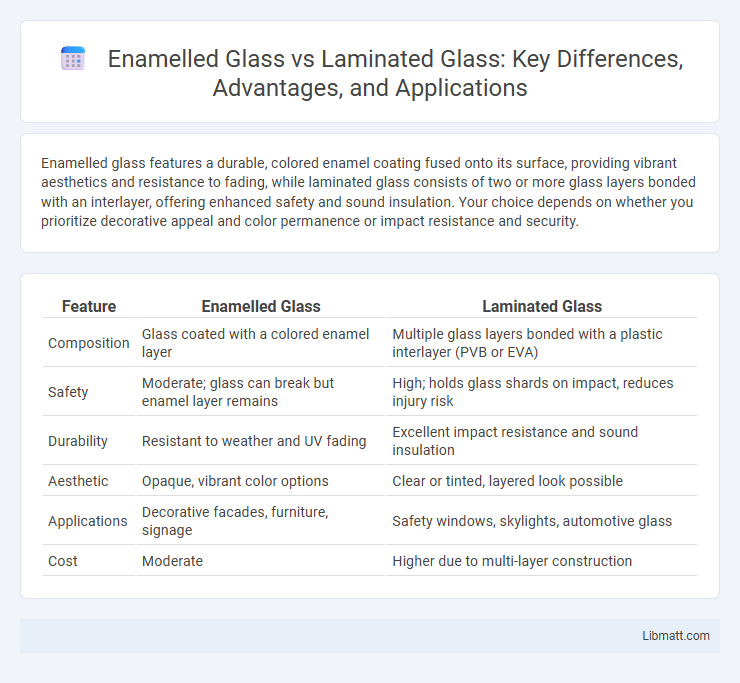Enamelled glass features a durable, colored enamel coating fused onto its surface, providing vibrant aesthetics and resistance to fading, while laminated glass consists of two or more glass layers bonded with an interlayer, offering enhanced safety and sound insulation. Your choice depends on whether you prioritize decorative appeal and color permanence or impact resistance and security.
Table of Comparison
| Feature | Enamelled Glass | Laminated Glass |
|---|---|---|
| Composition | Glass coated with a colored enamel layer | Multiple glass layers bonded with a plastic interlayer (PVB or EVA) |
| Safety | Moderate; glass can break but enamel layer remains | High; holds glass shards on impact, reduces injury risk |
| Durability | Resistant to weather and UV fading | Excellent impact resistance and sound insulation |
| Aesthetic | Opaque, vibrant color options | Clear or tinted, layered look possible |
| Applications | Decorative facades, furniture, signage | Safety windows, skylights, automotive glass |
| Cost | Moderate | Higher due to multi-layer construction |
Introduction to Enamelled Glass and Laminated Glass
Enamelled glass features a durable, colored enamel coating fused to the glass surface, providing vibrant aesthetics and enhanced resistance to scratches and weathering. Laminated glass consists of two or more glass layers bonded with an interlayer, offering superior safety, sound insulation, and UV protection. Your choice between enamelled and laminated glass depends on whether you prioritize decorative appeal or structural safety.
Composition and Manufacturing Process
Enamelled glass is created by fusing powdered glass mixed with color pigments onto a glass substrate through high-temperature firing, resulting in a durable, colored surface. Laminated glass consists of multiple glass layers bonded with an interlayer, typically polyvinyl butyral (PVB) or ethylene-vinyl acetate (EVA), using heat and pressure, enhancing safety and impact resistance. The manufacturing process of enamelled glass emphasizes color integration and surface durability, while laminated glass focuses on multi-layer lamination for structural integrity and shatter resistance.
Visual Appearance and Design Flexibility
Enamelled glass offers vibrant, opaque colors and smooth finishes ideal for artistic and decorative applications, providing high design flexibility with custom patterns and color layering. Laminated glass enhances visual depth and safety with its clear or tinted layers, allowing for subtle color options and embedded materials like films or fabrics to achieve unique aesthetic effects. Your choice depends on whether you prioritize bold, durable color impact or transparent, multilayered design possibilities.
Strength and Durability Comparison
Enamelled glass features a durable, heat-fused colored coating that provides high resistance to scratches and weathering, making it ideal for decorative and architectural applications. Laminated glass consists of multiple layers of glass bonded with a plastic interlayer, enhancing its impact resistance and preventing shattering upon breakage. Understanding the differences in strength and durability between enamelled and laminated glass helps you choose the best material for safety and longevity in your projects.
Safety and Security Features
Enamelled glass offers enhanced safety by incorporating a durable, colored ceramic coating fused during the tempering process, making it resistant to scratches and impacts while preventing sharp shards upon breakage. Laminated glass consists of two or more glass layers bonded with a polyvinyl butyral (PVB) interlayer that holds the shards together when shattered, providing superior security against forced entry and reducing the risk of injury. Both materials improve safety, but laminated glass excels in impact resistance and shatter containment, making it ideal for high-security applications.
Acoustic and Thermal Performance
Enamelled glass provides moderate thermal insulation due to its colored ceramic coating but offers limited acoustic dampening compared to laminated glass. Laminated glass excels in acoustic performance by using an interlayer that reduces sound transmission, making it ideal for noise-sensitive environments. Thermally, laminated glass enhances energy efficiency by incorporating specialized interlayers that improve heat retention and solar control.
Applications in Architecture and Interior Design
Enamelled glass enhances architectural and interior design applications through its vibrant color options, durability, and ability to provide decorative, easy-to-clean surfaces often used for walls, partitions, and kitchen backsplashes. Laminated glass is favored for safety-critical areas such as windows, balustrades, and facades, offering impact resistance, UV protection, and acoustic insulation while maintaining transparency. Both glass types contribute to modern design by blending aesthetics with functionality, where enamelled glass emphasizes color and texture, and laminated glass prioritizes strength and safety.
Cost Differences and Budget Considerations
Enamelled glass typically incurs higher upfront costs due to its specialized coating process and vibrant design options, making it a premium choice for decorative applications. Laminated glass offers more affordable pricing while providing enhanced safety and sound insulation, ideal for budget-conscious projects requiring durability. When planning Your budget, evaluating the balance between enamelled glass's aesthetic appeal and laminated glass's functional benefits ensures a cost-effective, tailored solution.
Maintenance and Longevity
Enamelled glass offers superior resistance to stains and scratches, making its maintenance simple with just regular cleaning, while laminated glass requires careful upkeep to avoid damage to its interlayer but excels in impact resistance and safety durability. Enamelled glass retains its vibrant color and surface quality for years without yellowing, whereas laminated glass may experience edge delamination or discoloration over time if moisture penetrates. Your choice between enamelled and laminated glass should consider the ease of cleaning for enamelled surfaces versus the enhanced security and sound insulation benefits provided by laminated glass's multi-layer construction.
Choosing the Right Glass for Your Project
Enamelled glass offers vibrant color integration and durable surface protection, ideal for decorative applications requiring high aesthetic appeal and scratch resistance. Laminated glass provides enhanced safety and sound insulation through its multi-layered construction, making it suitable for structural and security-focused projects. Selecting the right glass depends on balancing design needs with functionality, where enamelled glass excels in customization and laminated glass ensures strength and safety.
enamelled glass vs laminated glass Infographic

 libmatt.com
libmatt.com